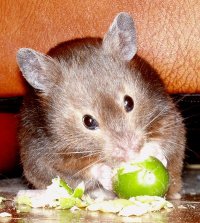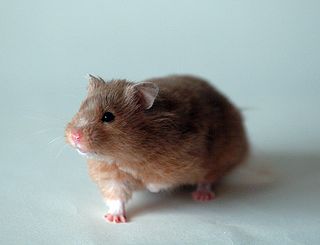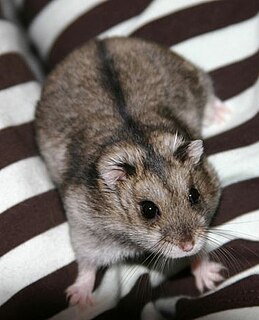
Hamsters are rodents belonging to the subfamily Cricetinae, which contains 19 species classified in seven genera. They have become established as popular small pets. The best-known species of hamster is the golden or Syrian hamster, which is the type most commonly kept as pets. Other hamster species commonly kept as pets are the three species of dwarf hamster, Campbell's dwarf hamster, the winter white dwarf hamster and the Roborovski hamster.

The golden hamster or Syrian hamster is a rodent belonging to the hamster subfamily, Cricetinae. Their natural geographical range is limited to a small arid region of northern Syria and southern Turkey. Their numbers have been declining in the wild due to a loss of habitat from agriculture and deliberate elimination by humans. Thus, wild golden hamsters are now considered Vulnerable by the International Union for Conservation of Nature.

Mouse-like hamsters are a group of small rodents found in Syria, Azerbaijan, Iran, Turkmenistan, Afghanistan, and Pakistan. They are found in rocky outcrops and semi-mountainous areas in desert regions.

The winter white dwarf hamster, also known as the Russian dwarf hamster, Djungarian hamster, striped dwarf hamster, Siberian hamster, or Siberian dwarf hamster, is one of three species of hamster in the genus Phodopus. It is ball-shaped and typically half the size of the Syrian hamster, so is called a dwarf hamster along with all Phodopus species. Features of the winter white hamster include a typically thick, dark grey dorsal stripe and furry feet. As winter approaches and the days shorten, the winter white dwarf hamster's dark fur is almost entirely replaced with white fur. In captivity, this does not usually happen as animals maintained as pets are generally housed indoors and exposed to artificial light that prevents the recognition of short winter daylengths. In the wild, they originate from the wheat fields of Kazakhstan, the meadows of Mongolia and Siberia, and the birch stands of Manchuria.
The Zagros Mountains mouse-like hamster is a relatively little-known rodent which was the first species of mouse-like hamster to be described. The species is distributed throughout much of southern Iran, particularly in the Zagros mountains. It is also known as the Iranian mouse-like hamster, though there are several species of mouse-like hamster found in different parts of Iran.

Campbell's dwarf hamster is a species of hamster in the genus Phodopus. It was given its common name by Oldfield Thomas in honor of Charles William Campbell, who collected the first specimen in Mongolia on July 1, 1902. It is distinguished from the closely related Djungarian hamster as it has smaller ears and no dark fur on its crown. Campbell's dwarf hamster typically has a narrow dorsal stripe compared to the Djungarian hamster and grey fur on the stomach. This hamster may be raised in captivity and kept as a small pet.

Phodopus, a genus of rodents in the hamster subfamily Cricetinae—a division of the larger family Cricetidae—is a lineage of small hamsters native to central Asia that display unusual adaptations to extreme temperatures. They are the only known hamsters that live in groups and, in some cases, rely on significant contributions by males to the raising of offspring. They are nocturnal and active throughout the year; they do not hibernate. Species of Phodopus, together with members of the genera Cricetulus, Allocricetulus and Tscherskia are called dwarf hamsters because of their small size relative to other hamsters.

The Roborovski hamster, also known as the desert hamster, Robo dwarf hamster, or simply dwarf hamster, is the smallest of three species of hamster in the genus Phodopus. It lives in the deserts of Central Asia, averaging under 2 centimetres (0.8 in) at birth and 4.5–5 centimetres (1.8–2.0 in) and 20–25 grams (0.71–0.88 oz) during adulthood. Distinguishing characteristics of the Roborovskis are eyebrow-like white spots and the lack of any dorsal stripe. The average lifespan for the Roborovski hamster is 2–3 years, though this is dependent on living conditions. Roborovskis are known for their speed and have been said to run up to 6 miles a night.

The suborder Myomorpha contains 1,524 species of mouse-like rodents, nearly a quarter of all mammal species. Included are mice, rats, gerbils, hamsters, lemmings, and voles. They are grouped according to the structure of their jaws and molar teeth. They are characterized by their myomorphous zygomasseteric system, which means that both their medial and lateral masseter muscles are displaced forward, making them adept at gnawing. As in the hystricognathous rodents, the medial masseter muscle goes through the eye socket, a feature unique among mammals. Myomorphs are found worldwide in almost all land habitats. They are usually nocturnal seed-eaters.

Cricetulus is a genus of rodent in the family Cricetidae ; it has seven member species that inhabit arid or semi-arid regions in Eurasia.

The European hamster, also known as the Eurasian hamster, black-bellied hamster or common hamster, is the only species of the genus Cricetus. It is native to grassland and similar habitats in a large part of Eurasia, extending from Belgium to the Altai mountains and Yenisey River in Russia. Historically, it was considered a farmland pest and had been trapped for its fur. Its population has declined drastically in recent years and is now considered critically endangered.

The Chinese striped hamster, also known as the striped dwarf hamster, is a species of hamster. It is distributed across Northern Asia, from southern Siberia through Mongolia and northeastern China to northern North Korea. An adult Chinese striped hamster weighs 20 to 35 g, and has a body length of 72 to 116 mm with a tail of 15 to 26 mm. It is smaller and has a much shorter tail than the greater long-tailed hamster, Tscherskia triton, which inhabits much of the same range.
The Mongolian hamster is a species of rodent in the family Cricetidae. It is one of two members of the genus Allocricetulus, and is found in China and Mongolia.
Beamys is a genus of rodent in the family Nesomyidae. It contains the following species:
The long-tailed dwarf hamster is a species of rodent in the family Cricetidae. It is found in China, Kazakhstan, Mongolia, and Russia.

The grey dwarf hamster, grey hamster or migratory hamster is a species of rodent in the family Cricetidae. Its range extends from Eastern Europe through the Middle East, Russia and Central Asia to Mongolia and western China. The grey dwarf hamster has grey fur and a head-body length ranging from 85 to 120 mm. The International Union for Conservation of Nature has assessed its conservation status as being of "least concern".
Sokolov's dwarf hamster is a species of rodent in the hamster and vole family Cricetidae. Previously listed as conspecific with Chinese striped hamster, it has been listed as a separate species since 1988. It has a distinctive dark stripe down its back on and otherwise grey body. It is found in China and Mongolia, and lives in burrows beneath desert shrubs.
The Romanian hamster or Dobrudja hamster is a species of rodent in the family Cricetidae. It is found in Bulgaria and Romania.











